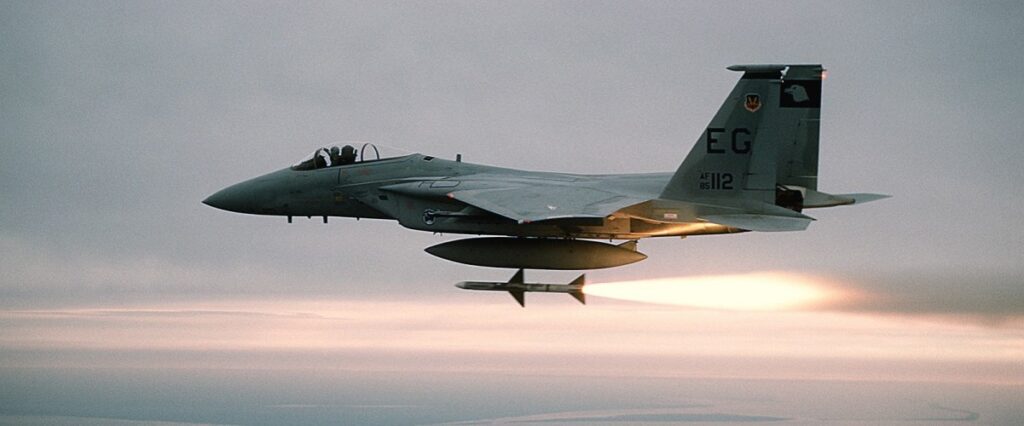‘The next pass was different. I said to Jim that our F-15 jockeys are the best in the world, let’s give them a challenge,’ Former SR-71 Blackbird pilot, Capt. Steve “Griz” Grzebiniak
The SR-71 Blackbird gathered intelligence in some of the world’s most dangerous environments during its 24 years of operation. The Blackbird is still the only US Air Force (USAF) aircraft to have never lost a crew member, either in the air or on the ground, having successfully avoided all 4,000 missiles fired at it.
The Blackbird was built to operate at extremely high altitudes and speeds; from 80,000 feet, it could cover 100,000 square miles of Earth’s surface per hour. It was therefore very difficult for any hostile fighter to get a radar lock on it. However, according to former Blackbird driver Col. Richard H. Graham, USAF (Ret.) two fighters could achieve (simulated) SR-71 kills, but only under certain conditions.
‘Don Emmons and I, as well as many other Habus, had flown numerous at “Tomcat Chase” and “Eagle Bait” sorties against our best fighters—the Navy’s F-14s and the Air Force’s F-15s,’ says Richard H. Graham, former SR-71 Blackbird pilot, in his book SR-71 Revealed The Inside Story. ‘We flew the SR to provide the fighters practice at finding, tracking, locking on, intercepting, and simulated firing of their sophisticated F-14 “Phoenix” missile and the F-15 ‘s AIM-7M “Sparrow” at a high-altitude, high-speed target. The “Tomcat Chase” missions were flown over the Pacific Ocean and the “Eagle Bait” missions the Nellis AFB training area.’
The AIM-7 Sparrow, the only all-weather missile deployed by the US Air Force (USAF), required the aircraft’s radar to continue tracking the SR-71 long after the missiles were launched. This was before the newest generation of air-to-air missiles (the AMRAAM, a fire-and-forget missile with an initial range of roughly 35 miles) was developed. The Sparrow had to remain locked on to the SR-71 for its Fire Control System (FCS) to relay tracking information back to the missile, so it could make appropriate corrections, racing towards the target. When the SR-71 aircrew activated their Defensive systems (DEF, pronounced “deaf”), they could easily prevent the F-15 aircraft from receiving any useful radar data to direct their missiles.
Graham continues;
‘All I ever heard on the radios from the fighters as they sped underneath us was, “Ah damn it, we’re too late!” We tried for years to get SAC Headquarters approval to practice the same intercepts with Det 1’s SR-71s against Kadena’s F-15s. Every Det 1 Commander, particularly Col. Lee Shelton, pushed to get the practice intercepts approved because they believed a lot could be learned by both aircraft. Eventually, SAC gave in to Colonel Shelton’s repeated requests and approved the practice intercepts. In order to get high enough to take a reasonable shot at us, F-15 crews were given special permission to do a zoom-climb to 50,000 to 55,000 feet before a simulated AIM-7 launch against the SR-71. They had permission to be above 50,000 feet for a maximum time of 90 seconds without wearing a pressure suit.’
Former SR-71 pilot, Capt. Steve “Griz” Grzebiniak, writes about the Kadena intercepts in Graham’s book SR-71 Revealed The Inside Story.
‘We flew the HABU as a high-altitude target for the F-15’s only on our infrequently scheduled “DEBBIE” training sorties. We were the fighter’s “training aid,” but it provided us with some valuable training and insight as well. I think it’s common knowledge that our aircraft and pilots are the finest in the world and if anyone could shoot down an SR-71, it would be one of our own.

‘Our pre-briefed mission required us to fly a specific track, at Mach 2.8 and no higher than 70,000 feet. In addition, we were required to fly over a designated point in space (the IP) and call our time out from the IP in one-minute intervals starting five minutes back. If that wasn’t enough, we would dump some fuel at the IP to help the fighters get a visual “tally” on us. After each mission, we would debrief by phone, and the F-15 drivers would report “four AIM-7s launched, four kills on the HABU.”
‘The next target sortie Jim and I flew had a different outcome. We were scheduled to make two passes over the intercept track. The F-15 guys were excited to have another chance to “smoke” the HABU. On the next pass, Jim and I flew the plan as briefed. One minute calls from the IP, on course, on altitude, Mach 2.8, “Here’s some fuel dump guys, come and get us.” The next pass was different. I said to Jim that our F-15 jockeys are the best in the world, let’s give them a challenge. Jim and I knew that we were flying our favorite jet, tail number 962—she never let us down. We came down the track to the IP, making our one-minute calls, but there was no fuel to dump because we were at 86,000 feet and Mach 3.2. The inlet doors were slammed shut and the jet was purring like a kitten. I made a shallow 10-degree bank turn, not so much to foil the F-15 ‘s intercept, but to allow Jim to see the contrails flailing below us.
‘In the phone debrief after the mission, the F-15 flight lead reported “four shots and four kills” on the first pass and mumbled something about radar problems and no kills on the second pass. Even with the world’s best planes, pilots, and missiles, it would take “a golden BB” [a lucky blind shot by the enemy] to bring down a HABU.’
Photo by MASTER SGT. Bill Thompson U.S. Air Force and Lockheed Martin

